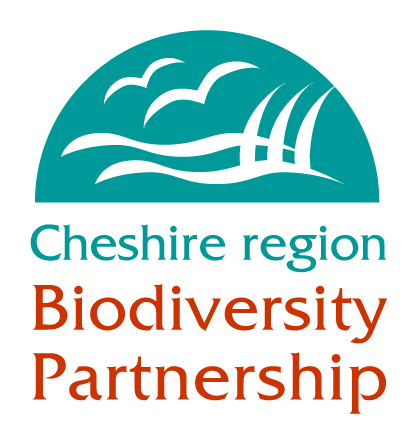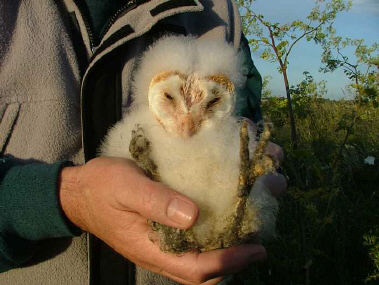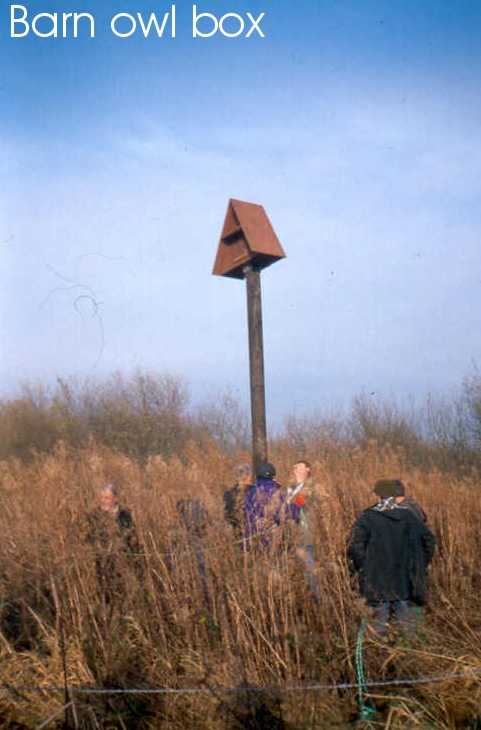BARN
OWL (TYTO ALBA)
LOCAL BIODIVERSITY ACTION PLAN
Links
to associated HAPs
Cereal
field margins, Bats, Unimproved
grassland, Farmland
birds
Current
Status
In the early part
of this century (1910) Coward & Oldham described the barn owl as being a
common but 'curiously local' resident (Guest et al 1992). In 1932 Blaker conducted
the first national barn owl survey, which revealed a population of 239 pairs
in Cheshire. Over the next 50 years the barn owl declined all over Britain,
primarily due to agricultural intensification. By the time the next national
survey was conducted by the Hawk and Owl Trust in 1982-5 the population in England
and Wales had crashed by 69%. In Cheshire the decline was even more severe,
down 85% and leaving just 35 pairs (Shawyer 1998). The results of Project Barn
Owl, a joint Hawk & Owl/BTO survey conducted between 1996-1998 are due to
be published shortly.
During 1998 only
7 pairs were confirmed as breeding by the Cheshire Barn Owl Project for the
whole of the Cheshire region, by 1999 this figure rose to 10. There were 19
breeding pairs of barn owls confirmed for the Cheshire region during 2000. There
were a total of 46 confirmed young, of which 44 fledged. This was very good
news for the project as the number of confirmed breeding pairs almost doubled
since the previous year. The breeding results for 2001 have shown an increase
in the number of confirmed breeding pairs in the county for the fourth successive
year. A total of 29 breeding pairs were monitored during 2001 with a total of
53 young being confirmed at those nest sites that were accessible. Unfortunately,
at eight of the total breeding sites the number of young could not be confirmed,
due to this the total number of young is expected to have been a higher figure.
The barn owl is protected
under Schedule 1 of the Wildlife and Countryside Act (1981), which makes it
illegal to disturb a barn owl at the nest. It is also listed under Schedule
9 of the Act, which means that a licence is required to release captive-bred
birds into the wild. It is also listed in the EC Birds Directive, Appendix ii
of the Bern Convention, which requires member states to take special measures
to conserve listed species.
 Threats
Threats
- Loss of rough grassland hunting
habitat as a result of agricultural intensification and urbanisation
- Loss of suitable nest and roost
sites, through felling of mature trees and conversion of farm buildings
- Declining small mammal populations
(a nationwide problem)
- Increased volume of speed of
road traffic, which accounts for the majority of deaths
How
are we helping to conserve the Barn Owl in the Cheshire region?
- Local Barn Owl Group members
collect sightings, monitor nest sites, conduct surveys, erect nest boxes
and visit farmers
- The barn owl is included in
the wildlife road casualty database compiled by Life ECOnet Project.
Objectives,
Targets and Actions
OBJECTIVES
|
LOCAL
TARGETS
|
|
To
increase the current population size and distribution of barn owls in
the Cheshire region.
|
To increase the population
of breeding barn owls in the Cheshire region to fifty pairs by 2020 |
ACTIONS
REQUIRED
|
-
Continue
to work towards establishing baseline population and distribution
data by encouraging the reporting of sightings and locating and
monitoring breeding pairs.
-
Continue
to input data onto database and map on an annual basis.
-
Continue
to survey areas of suitable habitat, particularly around known nest
sites.
-
Continue
to target farmers and landowners in areas with breeding pairs and
clusters of sightings to encourage breeding and increase the number
of chicks fledged.
-
Facilitate
dispersal and genetic diversification by the creation of corridors
of suitable habitat and nest sites between breeding pairs.
-
Erect
nest boxes in areas of suitable habitat where natural nest sites
are in short supply.
-
Expand
the local groups in the North, North East and Congleton & Macclesfield
areas of the Cheshire region, where there is enough support for
the group to become established.
-
Continue
to educate and raise awareness of the plight of the barn owl through
working with school and WATCH groups, carrying out talks and presentations
and gaining media coverage.
-
Continue
to work with local Universities on barn owl ecology research projects.
-
Continue
to hold regular meetings of the Local Barn Owl Groups forum and
the Local BAP Group.
-
Continue
to monitor and ring known breeding pairs and juveniles.
-
Continue
to gain financial support and provide training for each of the local
Barn Owl Groups in order to ensure their long-term existence and
self-sufficiency.
-
|
Progress
so far
| 2006
Action Completed |
-
The
year was started with 36 breeding pairs in the mid-Cheshire area,
a threefold increase since 2004. Across Cheshire as a whole the
number of breeding pairs has risen to 123.
- The
rest of the year seems to be showing a breeding slump however. This
may be due to unfavourable weather conditions.
- Regular
distance monitoring and nestbox checking continued.
-
Mid-Cheshire
Barn Owl Group attended the Cheshire Show.
-
The
Mid-Cheshire Barn Owl Group received a special award for their work
and the rest of the Cheshire Barn Owl Groups in recognition of the
work we all do. The award was presented by Mr David Briggs, High
Sheriff of the County of Chester and was accepted by John Mycock,
Chairman of the Mid Cheshire Barn Owl Conservation Group.
|
2005 Action
Completed
|
-
Wirral
Barn Owl Trust have continued to monitor barn owl populations and
breeding success throughout 2005 in Wirral.
-
30
pairs of barn owls have been identified on the Wirral Peninsula
by August 2005.
-
90
chicks had been seen by August 2005 and 73 chicks have been ringed.
-
In
a recent BASC
survey on the conservation work of their members it was found
that 32 barn owl boxes had been erected in Cheshire in the last
year.
|
1997-2004
Action Completed
|
-
In
November 1998 the project received funding through landfill tax
credits from 3C Waste with additional contributions from Vauxhall
Motors, Massey Bros., Hays Chemicals and Associated Octel.
-
Over
£2,000.00 has been raised for nest boxes and local Barn Owl
Group projects.
-
Four
active local Barn Owl Groups have now been established, all of which
have a committee and a strong, active membership.
-
Over
100 volunteers are now actively involved in the Cheshire Barn Owl
Project.
-
500
sightings posters have been distributed across the whole of the
Cheshire region.
-
Over
80 people have been trained in barn owl identification and surveying
and in habitat surveying and radio-tracking techniques.
-
A fundraising/sponsorship
workshop was held for the local Barn Owl Groups.
-
The
Cheshire LBAP Group now has representatives from over 20 different
groups and organisations.
-
Over
80 barn owl nest boxes have been erected in areas of good hunting
habitat.
-
During
the 2000 breeding season 17 pairs of barn owls were confirmed as
breeding producing over 40 chicks of which 24 were rung.
-
Nearly
20 talks and presentations have been given to WATCH groups, local
interest groups and other conservation/environmental organisations.
-
By
working with the North West Water & the Wildlife Trusts Otters
& Rivers Project and the Environment Agency, the mowing regime
of the River Gowy has been altered so as to maintain a stronger
food supply for barn owls during the breeding season.
-
Advice
and comments have been provided on several large-scale developments
affecting barn owl breeding sites and many other smaller scale developments
affecting areas of importance to barn owls across the Cheshire region.
-
Over
30 articles have appeared in the local press publicising the Cheshire
Barn Owl Project
-
Contact
has been made with the Cheshire Bat Group and the Cheshire &
Wirral Badger Group with a view to exchanging sightings and recruiting
new members.
-
Contact
has been made with and work on local projects been carried out in
partnership with the Barn Owl Conservation Network, Chester City
Council, Warrington Borough Council, National Trust, Duchy Of Lancaster
Estate, BNFL, Morgans, Vale Royal Borough Council, Environment Agency,
British Waterways & Crewe & Nantwich Borough Council.
-
Over
100 landowners and farmers have been contacted with regard to barn
owl sightings, nest box provision and habitat management for barn
owls.
-
A Cheshire
Barn Owl Project Display board has been produced for use at local
shows and exhibitions.
-
The
Cheshire Barn Owl BAP Group and the Local Barn Owl Groups forum
meet several times a year.
-
The
Cheshire Barn Owl Project action plan has been revised.
-
The
local Barn Owl Groups continue to expand; their hard work and enthusiasm
have created a better prospect for the barn owl in Cheshire.
-
The
Broxton Barn Owl Group has contacted over 300 landowners over the
past 6 years.
-
The
local barn owl groups are attracting funding which has enabled them
to purchase vital equipment and materials for nest boxes.
-
Species
recording card for barn owls produced by Cheshire County Council
and Vale Royal Borough Council.
-
The
Project Officer co-ordinated and facilitated the work of the seven
local barn owl groups and deals with conservation issues which related
to the entire Cheshire region.
-
In
2004 the Wirral Barn Owl Trust had an excellent
year in terms of increased numbers of pairs of confirmed breeding
Barn Owls (18) and much increased numbers of hatched chicks (71).
-
The
Wirral MBC Barn Owl live webcam is up and running at www.wirral-mbc.gov.uk/barnowls/
|
How
to find out more about Barn Owls
The
Wirral Biodiversity Action Plan for Barn Owls can be seen at
www.wirral.gov.uk/ed/biodiversity/bowl.htm
The Local Barn Owl Action Groups websites can be seen at
www.cheshirebarnowls.co.uk
and www.wirralbarnowltrust.org/
The Wirral barn owl webcam site, live from Wirral
Country Park can be seen at www.wirral-mbc.gov.uk/barnowls/
Vale Royal Borough
Council Barn Owl Species Recording card
How
can you get involved?
Join
your local Barn Owl Group (contact details below).
You
could sponsor a nestbox. Wirral Barn Owl Trust
scheme is aimed at everyone, from the individual or small group to the corporate
sponsor, who wants to help us re-establish the Barn Owl on the Wirral peninsula.
Your donation of £50.00 secures entry to a three-year scheme, ensuring
monitoring and maintenance of your adopted box for that period. More than one
nest box can be adopted. For more infomration visit their website (see
above).
Wirral
Barn Owl group also have a 'wishlist' of equipment they would like so they can
better their cause. If you can help them to obtain any
of the following either cheaply or even for free, please get in touch either
by email ([email protected])
or by telephone (0151 625 3969).
- 8'
x 4' sheets of exterior plywood (for nest boxes)
- Telegraph poles
- A scaffolding
tower
- Extending
laddersHard hats
- Safety
harnessesHeavy duty work gloves
- Waterproof
clothing
- Printing
- 90 gms
paper
- Photographic
gloss paper (A4)Barn Owl Taxidermy specimens (with Article 10 certificate)
- Barn Owl
photos/slides
- Data projector
(for PowerPoint presentations)
- Laptop
computer (for PowerPoint presentations)
Contact
details
|
Wirral
Barn Owl Trust
|
Broxton
(West Cheshire)
Barn Owl Group
|
Mid Cheshire
Barn Owl Group
|
North
Cheshire Barn Owl Group
|
South Cheshire
Barn Owl Group
|
Steve
Harris
PO Box 114
Hoylake
Wirral
CH48 8BX
0151 625 3969
|
|
John
Mycock
35 Burnside Way
Winnington Grange
Northwich
CW8 4XR
01606-75937
|
John
Mycock
35 Burnside Way
Winnington Grange
Northwich
CW8 4XR
01606-75937
|
John
Mycock
35 Burnside Way
Winnington Grange
Northwich
CW8 4XR
01606-75937
|
References
& Glossary
HMSO
(1995): Biodiversity: The UK Steering Group Report, Volume 1: Meeting the Rio
Challenge, London.
Shawyer, C. R. (1987): The Barn Owl in the British Isles: Its Past, Present
& Future, The Hawk Trust.
Shawyer, C. R. (1998): The Barn Owl, Arlequin Press.
Taylor, I. R. & Massheder, J. (1992): The dynamics of depleted and introduced
farmland barn owls, Tyto alba populations: a modelling approach.
The ecology and conservation of European owls. JNCC 1992. UK Nature Conservation
No. 5.


 Threats
Threats

